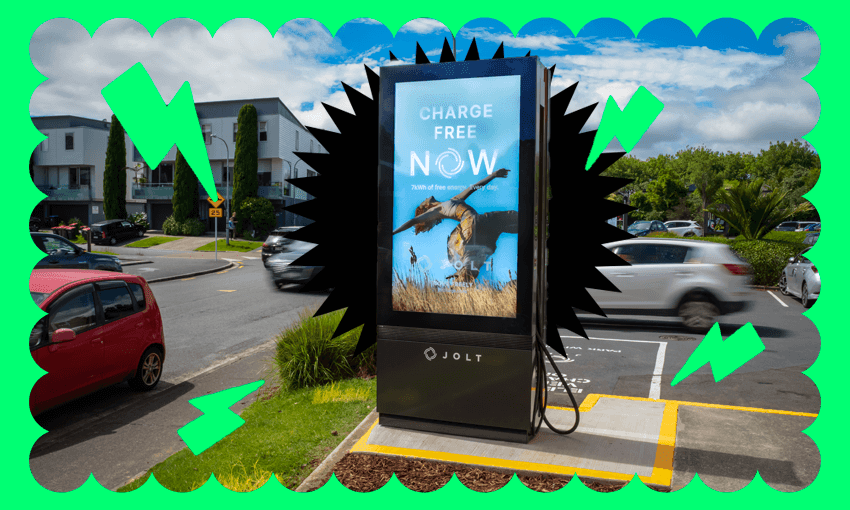An Australian company has big plans to double the number of public charging stations available to New Zealand EV owners. Will it work?
This is an excerpt from our weekly business newsletter Stocktake.
Having an electric car is the best. There’s the quiet hum of the electric engine, not having to stop for gas all the time, and the massive decrease in daily travel costs. When you’re sitting in Auckland traffic it’s easy to be smug with the knowledge you’re not idling away fossil fuels and instead doing your bit in the fight against climate change.
But owning an electric car can also be the worst. When you’re out and about and you need a top-up, public EV chargers are hard to come by. There are apps like EV Roam and PlugShare that can help you find one, and ChargeNet’s been going strong since 2014, but even then it’s not easy. Often when I’ve tried to use one, they’ve been broken, don’t have the correct fittings for our car or are just plain busy.
Ah yes, the queues. I’ve seen things get pretty feral around EV charging stations – drivers who block others in, cut others off, and generally display some pretty awful aggression towards other EV users. Clearly, as our dependance on New Zealand’s electric network grows, we’ve got a bit to learn about charging etiquette.
Jolt (not to be confused with the supercharged cola I drank way too much of as a student) is here to try and change that. The EV charging company builds charging stations in urban areas and retails spaces, giving drivers the chance to grab a quick top-up while they go about their day.
Jolt has grand plans to double the amount of electric chargers available on New Zealand roads across the next five years. With EV ownership skyrocketing nationwide, that’s a big deal. I asked Jolt’s country manager Chris Monaghan to explain his plan. (This conversation has been edited and condensed for clarity.)
Kia ora Chris. You’ve just launched New Zealand’s first Jolt EV charging station at Ponsonby’s Mitre 10 in Auckland. Tell me how it’s going to work.
We’ve just started our rollout in New Zealand, and we also have markets in Australia, the US, Canada and the UK. We have tens of thousands of charging stations in the pipeline – New Zealand is a great market to try new things and go hard. We started building last week, and we don’t stop building for about five years. We’re just constantly building. We’re looking at a program of [building] one to two chargers a week for the next five years, so it’s a quite a meaty program.
How can EV drivers access Jolt’s charging stations?
We provide 7kWh of free charging a day. That’s about 45 kilometres of driving. So, if you’re an EV driver, you can go to Jolt every day and get 45 kilometres of free driving. That will take about 15 minutes to charge. We’re offering a free top-up opportunity. You can keep charging and you’ll pay 50 cents a kWh, which is significantly better than anything else in the market.
Do you need an app to use one?
Yes. You go to the station, use the QR code and the charger activates. You’ll be able to see what chargers are available and reserve a charger. So if you’re in the vicinity of Grey Lynn, for example, you can reserve that charger and drive there and that’s yours.
If you’re giving away all this power for free, how does Jolt make any money?
You know digital displays in bus shelters? We have standalone 75-inch display screens, double-sided, and these are roadside. They display sustainable messaging and advertising. It’s the third-party advertising that allows us to provide the free charge, and then a low cost of charge going forward.
Where will people be able to find Jolt’s charging stations?
What you find with EV charging infrastructure right now is that it’s hidden behind a library, or the third floor of a car park. They’re very, very difficult to find. Unless you have an app, you wouldn’t know it’s there. Unless you have an EV you wouldn’t know EV infrastructure exists. We make it very visual. We’ll always have the screens roadside. We’re installing in urban spaces, retail areas, or council facilities, gyms and pools. That promotes to people that there is infrastructure for them to make that transition to EV.
Will we get to a point where you can roll into a former petrol station, grab a coffee and sausage roll and be fully charged and good to go in 15 minutes?
The petrol guys are going to hang on to liquid fuels for as long as they can, but they’re already investing in EV. If you go to the UK, BP already has charge-only stations. They’re beautiful, sustainable buildings. They look pretty cool. They’ll be doing rapid supercharges, which you’ll pay a lot more for. So that might be a 10- to 15-minute charge to get to 100%. That’s definitely coming. That’s why we want to play in the destination space and not the rapid-charging space because they’ve already got the property. They’ll own that area. We’re in the destination top-up area.



